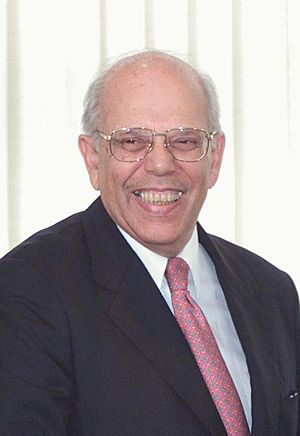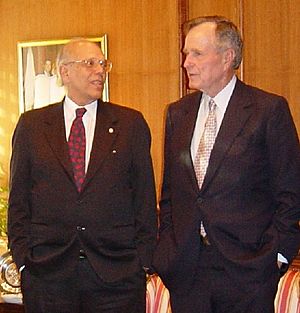Jorge Batlle facts for kids
Quick facts for kids
Jorge Batlle
|
|
|---|---|
 |
|
| 38th President of Uruguay | |
| In office 1 March 2000 – 1 March 2005 |
|
| Vice President | Luis Antonio Hierro López |
| Preceded by | Julio María Sanguinetti |
| Succeeded by | Tabaré Vázquez |
| Senator of Uruguay | |
| In office 15 February 1995 – 26 April 1999 |
|
| Constituency | At-large |
| In office 15 February 1985 – 29 May 1989 |
|
| Constituency | At-large |
| Representative of Uruguay | |
| In office 15 February 1959 – 15 February 1967 |
|
| Constituency | Montevideo |
| Personal details | |
| Born | 25 October 1927 Montevideo, Uruguay |
| Died | 24 October 2016 (aged 88) Montevideo, Uruguay |
| Resting place | Central Cemetery of Montevideo |
| Political party | Colorado Party |
| Spouses |
Noemí Lamuraglia
(m. 1957; div. 1983)Mercedes Menafra
(m. 1989) |
| Relations | Batlle family |
| Children | Raúl Lorenzo Beatriz |
| Parents | Luis Batlle Berres Matilde Ibáñez Tálice |
| Alma mater | University of the Republic |
Jorge Luis Batlle Ibáñez (born October 25, 1927 – died October 24, 2016) was an important Uruguayan politician and a lawyer. He served as the 38th president of Uruguay from 2000 to 2005.
Jorge Batlle was a member of the Colorado Party. Before becoming president, he worked as a National Representative from 1959 to 1967. He also served as a Senator of the Republic for two periods: from 1985 to 1990 and again from 1990 to 1999.
He was the eldest son of Luis Batlle Berres, who was also a president of Uruguay. Jorge Batlle came from the famous Batlle family, which had several members serve as president. He was the fourth person from his family to lead the country. He studied law at the University of the Republic and started his career as a journalist.
His time as president was challenging. Uruguay faced some tough economic times and a serious animal health problem. President Batlle worked to create the Commission for Peace, which investigated human rights issues from a past period in Uruguay. His government also worked to strengthen Uruguay's relationships with other countries, like the United States.
Jorge Batlle: A Leader for Uruguay
Early Life and Learning
Jorge Luis Batlle Ibáñez was born in Montevideo, Uruguay, on October 25, 1927. His parents were Luis Batlle Berres and Matilde Ibáñez Tálice. He had two younger siblings, Luis and Matilde.
His family, the Batlle family, came from Sitges, Catalonia, Spain. This family has a long history in Uruguayan politics, with several members becoming president. For example, José Batlle y Ordóñez, a famous former president, was his great-uncle. Jorge's family background was a mix of Catalan (from his father's side) and Italian (from his mother's side).
Jorge went to the Elbio Fernández School and the German School of Montevideo. He later studied at the University of the Republic, where he earned a law degree in 1959.
Starting in Politics
Before he was first elected as a Congressman for the Colorado Party in 1958, Jorge Batlle was already active in journalism. He worked at Radio "Ariel" and for the newspaper "Acción." He was also a member of his party's leadership group.
Leading His Party
In 1965, Jorge Batlle became the main leader of "List 15" within the Colorado Party. This position became available after his father passed away. He suggested changing Uruguay's government system back to a presidential one, where one president leads the country. He helped write and promote the changes that led to the 1967 Constitution.
A Time of Change and Return to Democracy
During a period when Uruguay's government included both civilian and military leaders (from 1973 to 1985), Jorge Batlle was not allowed to hold political office. He was held for questioning several times during this period. However, he played an important role when democracy returned. In February 1985, he led the meeting where the first democratically elected Congress took office after this period. He was very active in making new laws and helped create two important changes to the Constitution in 1966 and 1996.
President of Uruguay (2000-2005)

Jorge Batlle became president at a very challenging time for Uruguay. The country was facing tough economic problems.
Facing Economic Challenges
Uruguay was going through a difficult economic period, with problems in its banks. Many people were struggling financially. President Batlle worked hard to manage government spending carefully. His efforts helped Uruguay be seen as a country that handled its money wisely. The President of the United States, George W. Bush, even helped Uruguay with a large amount of credit to prevent further financial difficulties.
Dealing with Health Issues for Animals
During his presidency, there was an outbreak of foot-and-mouth disease among animals. This was a big problem because it threatened Uruguay's ability to sell its beef to other countries. President Batlle's administration worked diligently, and before his term ended, Uruguay was able to get rid of the disease and regain its status as a disease-free country for beef exports.
Working with Other Countries
President Batlle strongly supported MERCOSUR, a group of South American countries working together on trade. He believed it was important for Uruguay to be part of a larger regional economy. He also wanted to strengthen ties with the United States. While some other countries in Latin America were moving away from the U.S., Batlle's government kept close diplomatic relationships. He also had disagreements with the government of Cuba regarding how they treated their citizens.
Helping Families Find Answers
A very important part of President Batlle's time in office was his focus on human rights. He helped create the Commission for Peace. This group worked to investigate what happened to people who went missing during the period when the government included both civilian and military leaders. He also announced the discovery of Macarena Gelman, the granddaughter of an Argentine poet, who was born to a mother who had disappeared. This brought closure to a long-standing mystery.
After His Presidency
His Final Years
Even after his presidency ended in 2005, Jorge Batlle remained active in politics. He often shared his opinions about the presidents who came after him, Tabaré Vázquez and José Mujica, through newspaper articles and social media.
Death and Funeral
On October 24, 2016, Jorge Batlle sadly passed away, just one day before his 89th birthday. He had fainted during an event and hit his head, leading to an intracranial hemorrhage. He was hospitalized and underwent surgery, but it was unsuccessful. Uruguay declared a day of national mourning to honor him.
Personal Life
Jorge Batlle married Noemí Lamuraglia in 1957. They had two children, Beatriz (born in 1962) and Raúl Lorenzo (born in 1965). Later, he married Mercedes Menafra in 1989.
Documentary
- Jorge Batlle: entre el cielo y el infierno. This is a 2024 documentary film directed by Federico Lemos about his life.
See also
 In Spanish: Jorge Batlle para niños
In Spanish: Jorge Batlle para niños
- Politics of Uruguay
- List of political families#Uruguay

